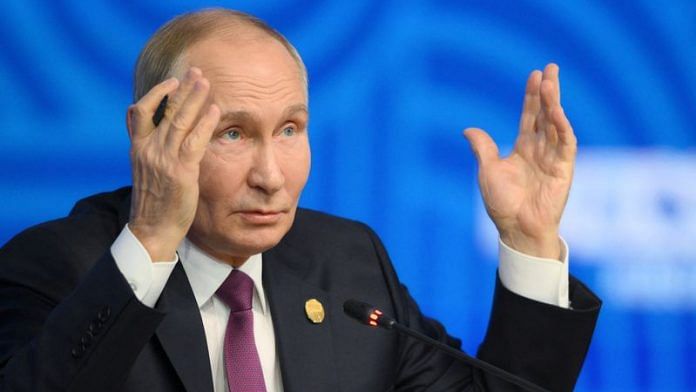Thank you dear subscribers, we are overwhelmed with your response.
Your Turn is a unique section from ThePrint featuring points of view from its subscribers. If you are a subscriber, have a point of view, please send it to us. If not, do subscribe here: https://theprint.in/subscribe/
Russia has organised its 15th Vneshtorgbank (VTB) Investment Forum, known as the Invest in Russia Summit, in Moscow on 4th December 2024 to attract foreign and domestic investors by showcasing opportunities that the Russian economy can offer. It brings together the policymakers, industry leaders, and investors to discuss various aspects of investment in Russia. Russia’s renewed focus on initiatives like the Invest in Russia Summit is an approach to drive investments, improve Russia’s global image as a business destination, and enable economic growth.
Challenges Shaping the Summit:
Western sanctions have significantly restricted Russia’s access to global financial markets and trade opportunities, resulting in reduced foreign investment and economic contraction. This has pushed Russia to explore new ways to revive the economy and find alternative economic pathways. The Ukraine war has significantly impacted Russia, eroding its economy. The Summit is a step toward rebuilding and stabilising Russia’s economic framework.
Delving into Russia’s Economic Journey:
The Russian economy has shaped itself significantly over the years from a centrally planned system to a market-orientated economy.
- 1990s Transition: The post-Soviet economic shift caused GDP to plummet by 40%, driven by structural reforms, hyperinflation, and economic instability.
- 2000s Growth: Benefiting from high oil prices, Russia saw robust GDP growth, averaging 7% annually until 2008.
- Post-2014 Sanctions: Economic growth slowed significantly due to Western sanctions and falling oil prices, with annual growth averaging 1-2% between 2015 and 2021.
- Ukraine War Impact: The war exacerbated economic instability, leading to further contraction in 2022.
Despite these challenges, Russia has managed to demonstrate resilience. Inflation surged to 13-15% in 2022 due to sanctions and supply chain disruptions. However, monetary tightening, spending cuts, and tax reforms have since helped stabilize prices. Remarkably, unemployment remained low at 4%, even amid uncertainties.
Fiscal Stability and Trade Dynamics
Russia’s fiscal policies and trade strategies have played a crucial role in maintaining economic stability:
- Budget Surpluses: Since the 2000s, Russia has leveraged oil revenues to maintain budget surpluses and build substantial reserves, reaching $600 billion by 2022. Although sanctions froze nearly half of these reserves, access to gold and yuan reserves has mitigated the impact.
- Shifting Trade Focus: While trade with Western countries has significantly declined, exports to non-Western allies have increased, enabling Russia to maintain a trade surplus.
- Currency Measures: The ruble faced volatility in 2022 due to sanctions, prompting Russia to impose capital controls and promote local currency trade to stabilize its economy.
External debt remains low at 20% of GDP, reducing Russia’s exposure to global financial crises.
Sectoral Opportunities and Challenges
Russia’s economy heavily relies on its oil and gas sector, which contributes 20-25% of GDP and accounts for 50% of budget revenues. Alongside this, sectors like technology, agriculture, infrastructure, and renewable energy present significant growth potential. However, limited R&D investment, technological dependencies, and demographic challenges, including a shrinking workforce and emigration, pose long-term risks.
Strengthening India-Russia Trade
In July 2024, India and Russia agreed to boost bilateral trade to over $100 billion by 2030. This partnership includes increased investments, the use of national currencies for trade, and enhanced cooperation in sectors like energy, agriculture, and infrastructure.
- Current Trade Figures: Bilateral trade grew to $65.42 billion in 2023-24, up from $49.4 billion in 2022-23.
- Trade Imbalance: The trade gap heavily favours Russia, driven by India’s surge in crude oil imports, which were purchased at discounted rates following Western sanctions on Russian oil.
As the world’s third-largest crude importer, India has leveraged this opportunity to deepen its economic ties with Russia.
Russia’s Strategy: Empowering Sovereignty
Yes, Russia has been encouraging the idea of sovereignty for nations, specifically in the context of economic independence to counter Western dominance, including the global reliance on the US dollar and the influence of English as a global language. Reasons being: de-dollarization, promoting a multipolar world rather than aligning with a single global hegemon (the US), defending local languages and cultural heritage in allied nations, partnering with “Global South” nations, and strengthening regional currencies in global trade.
Conclusion:
Despite the sanctions and war, Russia has been resilient due to its fiscal prudence, resource wealth, and pivot to non-Western trade. The message of sovereignty resonates with nations seeking alternatives to Western dominance. The Summit is going to create opportunities for investors to connect with local businesses and government and provide a platform to discuss market trends, challenges, and strategies to enter the Russian market. It is also seen as an effort to highlight the sectors such as energy, technology, agriculture, infrastructure, and renewable energy in Russia that have a good growth potential.
These pieces are being published as they have been received—they have not been edited/fact-checked by ThePrint.


